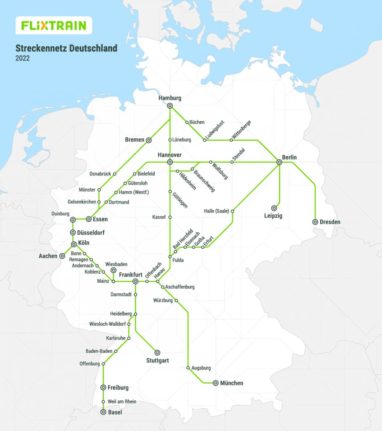The low-cost provider, which is offering 10 franc (10 euro) tickets between Berlin and Basel, among other cheap fares, arrived for the first time at Basel-Bad train station on Thursday evening. The station is situated on Swiss soil, but is operated by the German railway company Deutsche Bahn.
Flixtrain’s maiden arrival sparked criticism from Switzerland’s Transport Staff Union (SEV), which said the train is operated by underpaid subcontractors and has announced it would “track down any attempt to underbid in terms of salary, training and working conditions”.
“We will never accept companies that run on rail in Switzerland without a collective labour agreement and with working conditions unworthy of the name”, said SEV’s president, Giorgio Tuti.
READ MORE: What is a Swiss collective bargaining agreement — and how could it benefit you?
The low-cost company, which has been establishing itself Deutsche Bahn’s major competitor Germany over the past few years, runs long distance bus and train services.
When will the services run?
The lines to and from Basel run from Thursday to Monday, with one connection per day in either direction.
It will take 8 hours and 45 minutes from Basel Badischer Bahnhof to Berlin Hauptbahnhof.
A trip with the German ICE will instead take just over 7 hours.
The new line is part of an expansion of services which is set to include around 70 destinations in Germany.
OK but will it really cost CHF10?
The price of the ticket grabbed headlines, with Flixtrain saying in its press conference that the almost-nine-hour trip would only cost CHF10 (10 euro).
Flixtrain spokesperson Sebastian Meyer told Swiss news outlet Watson that tickets would start at CHF10, but more expensive tickets would be available when the CHF10 offerings were sold out.
“If the cheapest ticket contingent is sold out, the next higher one takes effect. In this way, we can always offer our passengers cheap tickets. Affordable prices are still possible due to the corresponding utilisation of the individual trips.”
In order to get the cheapest possible fare, travellers are advised to book early.
REVEALED: How to find cheap train tickets in Switzerland
Tickets between Basel and Berlin can cost as high as CHF150 or 160 euros from Switzerland’s SBB or Germany’s Deutsche Bahn respectively, although booking in advance can bring the price down to as low as CHF30.
Where will the train to (and from) Berlin stop?
In either direction, the train will stop at: Karlsruhe, Baden-Baden, Offenburg, Freiburg, Wiesloch, Bad Hersfeld and Weil am Rhein.
What else is different about Flixtrain?
Other than being bright lime green, Flixtrains allow you to take your bicycle with you, which is not allowed on most ICE long-distance trains in Germany.
Are there any other destinations within Switzerland?
As yet, Basel will be the only Swiss destination. The other two new routes are Stuttgart to Hamburg and Berlin to Weisbaden.
In addition to the 10 franc (10 euro) ticket from Basel to Berlin, other journeys within Germany will start at 5 francs (5 euros).
More information is available from Flixtrain at the following link.
The expanded routes can be seen in the following image.

A look at Flixtrain’s route network in 2022. Map: Flixtrain



 Please whitelist us to continue reading.
Please whitelist us to continue reading.
Member comments